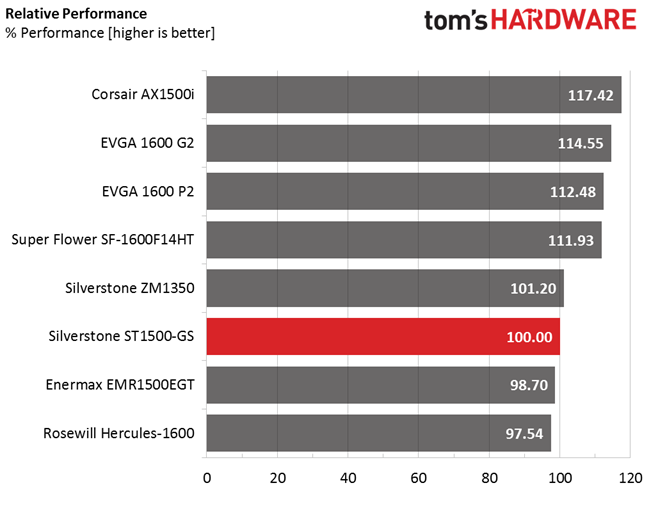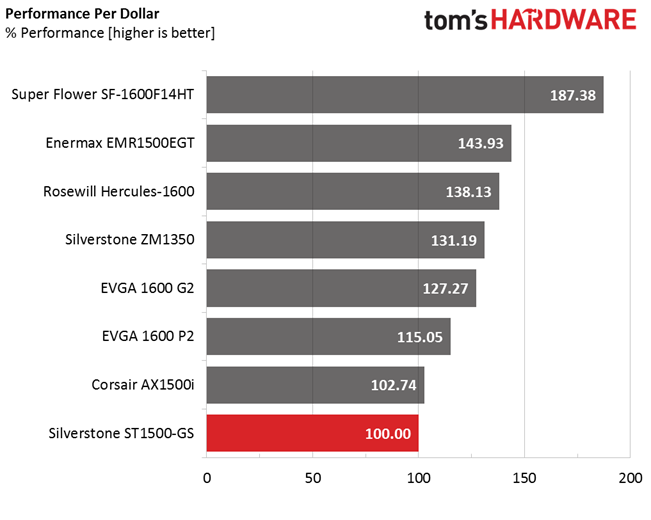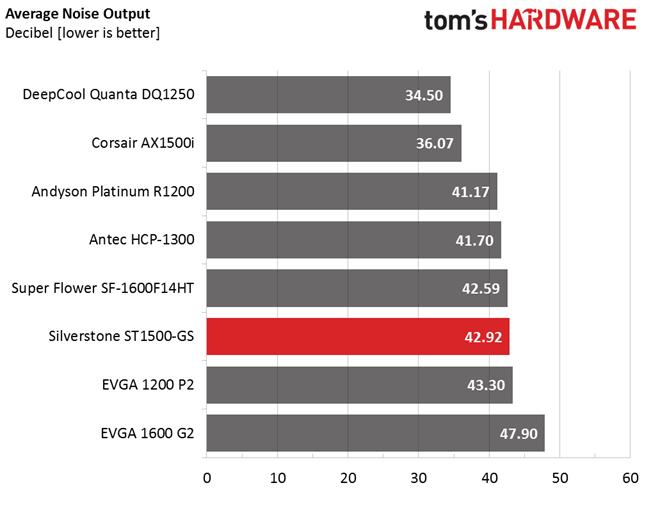SilverStone Strider Gold S 1500W PSU Review
SilverStone has a long tradition of offering small PSUs, and the new ST1500-GS is an excellent example of this, achieving an impressive 646 watt per liter power density score.
Why you can trust Tom's Hardware
Performance, Performance Per Dollar And Noise Ratings
Performance Rating
The following graph shows the total performance rating of the PSU, comparing it with other units we have tested in the past. To be specific, the tested unit is shown as 100 percent, and every other unit's performance is shown relative to it.
The ST1500-GS managed to surpass the Enermax Maxrevo's 1500 performance, a unit that has the same capacity, efficiency rating and power density but is based on an older platform and costs much less than the SilverStone unit. When compared with the EVGA and Super Flower high-capacity offerings, the SilverStone unit didn't stand a chance in terms of performance.
Performance Per Dollar
The following chart may be the most interesting to many readers because it depicts the unit's performance-per-dollar score. We looked up the current price of each PSU on popular online shops and used those prices and all relative performance numbers to calculate the index. If the specific unit wasn't available in the United States, we searched for it in popular European Union shops, converting the listed price to U.S. dollars (without the VAT). Note that all of the numbers in the following graph are normalized by the rated power of each PSU.
The high price along with the not-so-high performance didn't allow for a better score here. SilverStone should cut the price of the ST1500-GS unit in order to help it achieve a better place in this important comparison.
Noise Rating
The graph below depicts the cooling fan's average noise over the PSU's entire operating range, with an ambient temperature between 28 and 30 degrees Celsius (82 to 86 F).
The large SilverStone PSU manages to register a significant difference when compared with the Gold efficiency EVGA unit, and has almost the same overall noise output as the more efficient Super Flower Titanium unit. When looking at the ultra-high capacity units only, the Corsair AX1500i achieves an out-of-this-world performance, proving its superiority in the noise output category as well.
Get Tom's Hardware's best news and in-depth reviews, straight to your inbox.
Current page: Performance, Performance Per Dollar And Noise Ratings
Prev Page Ripple Measurements Next Page Pros, Cons And Final Verdict
Aris Mpitziopoulos is a contributing editor at Tom's Hardware, covering PSUs.
-
Eggz Too bad for this model, but I can't wait to see what this watt-per-litre ratio does for SFX!Reply -
InvalidError I would not be that bothered by the lack of a physical switch: most people plug their PC in a power strip, surge protector or UPS and these usually have their own switch.Reply
Someone bothered enough by the 5VSB power draw to bend under their desk or reach over wherever the switch ends up being in their setup to switch the PSU off should be similarly bothered by the standby power draw of their displays, USB hub, external HDDs and other devices enough to want to turn them all off as well. The simplest way to achieve that is plugging everything into one power strip and turning everything on/off at once from there.
Also, leaving the 5VSB supply on 24/7 costs less than $0.20/year in power. How much does a replacement CR2032 battery cost and how many power-off hours does it last? It might be cheaper to leave the 5VSB power on.
The only time where I cut power completely off is during power outages to spare my components all the surges and sags over the first few seconds after power comes back on. -
Blueberries I don't think I'll ever have a use personally for a 1500w PC, but if I need that kind of juice this is exactly what I'd be looking at.Reply
Not the best option, clearly, but what you'd expect from a Gold rated PSU and solid build integrity that should last a long time. I would test this PSU without a fan or with a low noise Noctua fan. -
jimmysmitty ReplyI would not be that bothered by the lack of a physical switch: most people plug their PC in a power strip, surge protector or UPS and these usually have their own switch.
Someone bothered enough by the 5VSB power draw to bend under their desk or reach over wherever the switch ends up being in their setup to switch the PSU off should be similarly bothered by the standby power draw of their displays, USB hub, external HDDs and other devices enough to want to turn them all off as well. The simplest way to achieve that is plugging everything into one power strip and turning everything on/off at once from there.
Also, leaving the 5VSB supply on 24/7 costs less than $0.20/year in power. How much does a replacement CR2032 battery cost and how many power-off hours does it last? It might be cheaper to leave the 5VSB power on.
The only time where I cut power completely off is during power outages to spare my components all the surges and sags over the first few seconds after power comes back on.
While I agree with you for the most part, I have had a set of Creative Labs speakers for 10 years that have a remote that use a CR2032 and it is still good with plenty of use and standby time.
I do agree though that it is annoying not to have the switch on the PSU. Of course I look at it from a repair point of view where having that option is faster than pulling the plug every time I would need to test something. -
InvalidError Reply
A good battery-operated remote tries very hard to minimize leakage and standby current while a computer RTC which may expect to have 5VSB power available all the time except during power outages has little reason to go to extremes to minimize battery power draw.16447176 said:While I agree with you for the most part, I have had a set of Creative Labs speakers for 10 years that have a remote that use a CR2032 and it is still good with plenty of use and standby time.
My old Sears TV's remote drains 4xAA in less than a year. -
mctylr ReplyI would not be that bothered by the lack of a physical switch: most people plug their PC in a power strip, surge protector or UPS and these usually have their own switch.
In my experience the power supply switch is primarily a convenience, used to ensure a power supply and connected system is de-energized when servicing the computer; inserting or removing components, such as swapping video cards, installing storage drives, etc. This is because the 5VSB (5 volt stand-by) is supplied by the motherboard to PCI and PCI express slots, as well as obviously flowing across a few of the PCB traces, so it is recommended to disconnect power, including stand-by voltage to prevent accidents.
-
Frozen Fractal Errrm, there's a typo in the article. Look at page 3, the same paragraph has been repeated :)Reply -
Frozen Fractal While I don't bother about in-build power switches so much since I always switch off/on via the main wall socket anyway, but it's a nice addition to cater to everyone's need, which is especially expected in these kind of high-wattage PSUs. When we talk about 1.5kW, compromise is what people would reluctantly want.Reply
Judging by the actual results of the PSU, I think "80+ Silver" should've fitted nicely with it. That way, it wouldn't defame "80+ Gold" Standard :P What I mean actually is, it's barely holding on to the 80+ gold standard. While it doesn't actually translate to significant deal breaker, it's somewhat disappointing to see 550W-approved things in this 1.5kW unit.
However, the PCB neatness certainly gets my thumbs up. Among the most units I've seen from different distributors and OEMs, this one looks very neat (apart from the gooey use of solder there, Ewwww!), components are arranged very nicely, and there aren't any glue (or whatever you wanna say them) oozing out from or underneath heatsinks and FETs.


